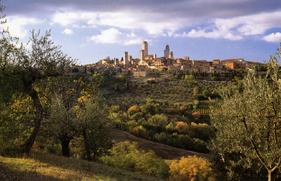It stands, with its celebrated towers, on a hill 334 metres (c.1000 feet) high, in a zone originally inhabited by the Etruscans.
San Gimignano developed between the 9th and 12th centuries, with the flourishing of urban civilisation, thanks above all to its geographical position, situated as it is between the Via Pisana that led to the sea and the Via Francigena, a vital axis of European communications until the sixteenth century. In the 12th century it became a free commune, supported by the Ghi-bellines, and thanks to its trade, especially in saffron, it also became a mercantile centre of great importance, which permitted the growth of a strong city aristocracy.
The powerful defensive walls were witnesses of the development of the city, as were the fine churches, the many noble mansions and above all the 72 towers built by noble families of the city as a symbol of their power and importance. The economic and political decline of the town had already begun by the fourteenth century, because of a series of linked causes, among which were the strong dissensions within the town itself and the powerful pressures of the great Tuscan cities, notably Firenze and Siena.



